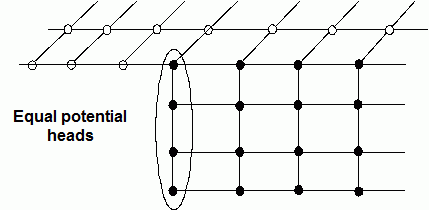The transition between 2D and 3D model areas requires special consideration in the calculation.
According to the Dupuit assumption, the prerequisite for a two-dimensional horizontal model is horizontal flow. This means that there must be no velocity in the Z direction at the transition point between the 2D model and the 3D sub-region.
A good method of defining this transition condition is to equate the potential heads via the height. When using the data type , a secondary condition is defined for the system of equations that sets the potential heads (here: of the nodes lying on top of each other) to an equal value that is not known before the calculation.
The entered boundary of the 3D area (3DRA) is used to determine whether a fully three-dimensional area is being calculated or a 3D sub-area. Since in the first case the 3D boundary nodes are boundary nodes of the model at the same time, equating is not possible. Boundary conditions of either type 1 (fixed potential head) or type 2 (flux) must be explicitly specified at these nodes.

Transition condition from 2D to 3D area
 Realization in SPRING
Realization in SPRING